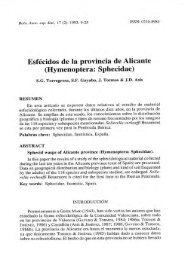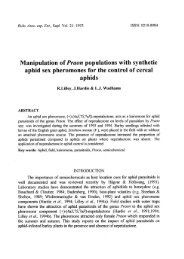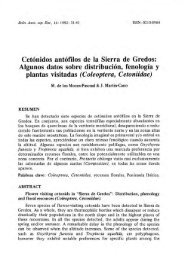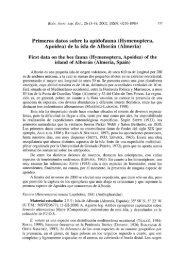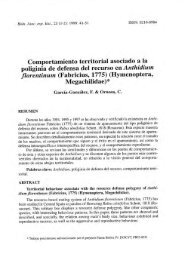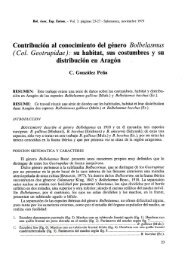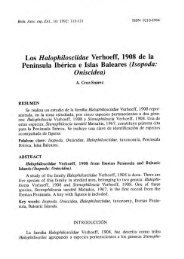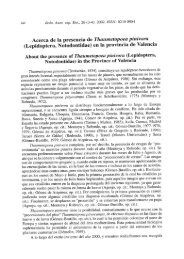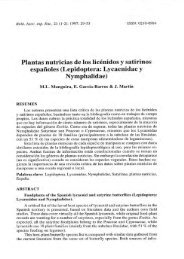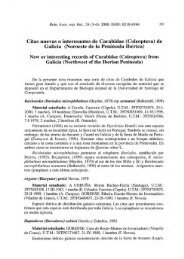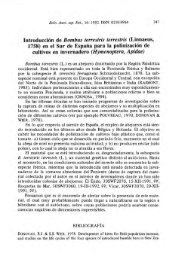Libro 1.indb
Libro 1.indb
Libro 1.indb
Create successful ePaper yourself
Turn your PDF publications into a flip-book with our unique Google optimized e-Paper software.
GALL MIDGES (DIPTERA: CECIDOMYIIDAE) OF THE IBERIAN PENINSULA 107<br />
mericarp. This species was described by E. Sylvén from the type-locality Algarve, Albufeira<br />
in Portugal. Occurrence: very scarce (Fig. 41). Reference: SYLVÉN & TASTAS-DUQUE<br />
(1993). Distribution: Mediterranean.<br />
Dasineura fraxini (Bremi, 1847)<br />
Larvae cause swellings of the mid-vein on the leaflets of Fraxinus excelsior L. (Oleaceae).<br />
Occurrence: scarce (Fig. 41); Engolasters and Sispony (Andorra, 1992-1993), Matadepera<br />
(Barcelona, 1980) and Montseny (Barcelona, 1995), leg. Pujade-Villar. Reference: SKUHRAVÁ<br />
et al. (1996). Distribution: European.<br />
Dasineura galiicola (F. Löw, 1880)<br />
Larvae form artichoke-shaped galls on Galium uliginosum L. (Rubiaceae). Occurrence: very<br />
scarce (Fig. 42); Matadepera (Barcelona, 1987) leg. Pujade-Villar. References: SKUHRAVÁ<br />
et al. (1996). Distribution: Euro-Siberian.<br />
Dasineura gleditchiae (Osten Sacken, 1866)<br />
Larvae change into galls the leaflets of Gleditsia triacanthos L. (Caesalpiniaceae). Occurrence:<br />
very scarce (Fig. 42). Reference: ESTAL et al. (1998). Distribution: Nearctic, immigrant<br />
in Europe.<br />
Dasineura halimii (Tavares, 1902)<br />
Larvae change terminal or axillar leaf buds in fusiform galls on Halimium ocymoides (Lam.)<br />
Willk. in Willk. & Lange (= H. heterophyllum Spach) and H. alyssoides (Lam.) (= H. occidentale<br />
WK) (Cistaceae). Each gall with solitary red larva. Occurrence: medium frequent<br />
(Fig. 43). References: TAVARES (1902d, 1905a, 1909, 1919), COGOLLUDO (1921). Distribution:<br />
Mediterranean, endemic to the Iberian Peninsula.<br />
Dasineura herminii (Tavares, 1902)<br />
Orange coloured larvae cause globular galls on stem tips of Halimium alyssoides (Lam.) (=<br />
Halimium occidentale WK) (Cistaceae). The gall is formed of many deformed leaves and is<br />
inhabited by many larvae. Occurrence: medium frequent (Fig. 43). References: TAVARES<br />
(1902d, 1905a, 1909, 1919), COGOLLUDO (1921). Distribution: Mediterranean, endemic<br />
to the Iberian Peninsula.<br />
Dasineura hygrophila (Mik, 1883)<br />
Larvae produce globular leaf galls on growing points of Galium debile Desv. (= G. palustre<br />
L.), G. elodes Hoffgg. (Rubiaceae). Occurrence: very scarce (Fig. 44). References: TAVARES<br />
(1902b, 1905a). Distribution: Euro-Siberian.<br />
Dasineura hyperici (Bremi, 1847)<br />
Larvae cause leaf bud galls on Hypericum undulatum Schousb. (Hypericaceae). Occurrence:<br />
very scarce (Fig. 44). Reference: TAVARES (1902a). Distribution: European.<br />
Dasineura ilicis (Tavares, 1919)<br />
Perrisia ilicis Tavares, 1919<br />
Larvae live on leaves of Quercus ilex L. (Fagaceae), probably as inquilines or comensals of<br />
larvae of Contarinia luteola Tav. Occurrence: scarce (Fig. 45). References: TAVARES (1919,<br />
1920). Distribution: Mediterranean, endemic to the Iberian Peninsula.<br />
Boln. Asoc. esp. Ent., 30 (1-2): 93-159, 2006



